Handling and Features
Performance
Verdict
Specification

This super-zoom lens for Nikon DX format DSLRs covers a huge 16.7x zoom range, equivalent to 27-450mm on a 35mm camera. It sports internal focusing, and Nikon's Vibration Reduction system. Nikon already has a super-zoom lens covering this range, but the older version has a brighter f/5.6 maximum aperture at 300mm, which makes the older lens more bulky. In this review, we'll see if the new, more compact design is a welcome change
Nikon AF-S DX Nikkor 18-300mm f/3.5-6.3G ED VR Handling and Features
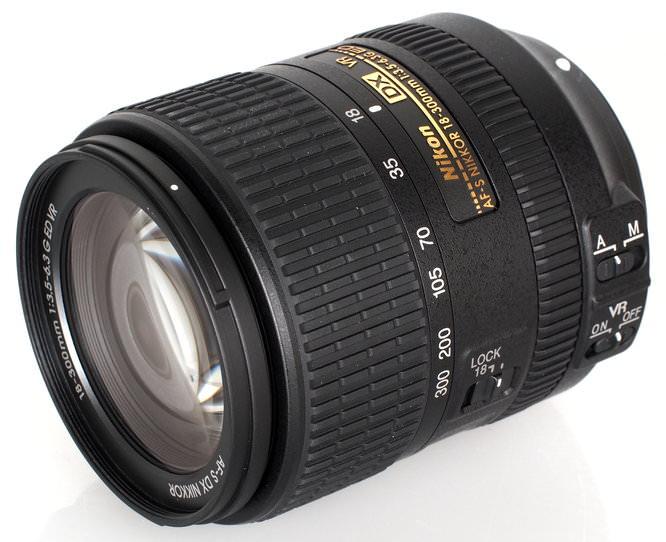
For a lens covering such a huge zoom range, this lens is relatively compact and lightweight, only weighing 550g. In fact, size-wise, it is no larger or heavier than Nikons' 18-200mm lenses, which makes it a much better candidate as a walkabout than the previous 18-300mm lens. It feels right at home on the Nikon D7100 body used for testing, and will make a good companion for Nikon's smaller, entry level bodies as well. As is the case with Nikon's other consumer-grade lenses, high quality plastics have been used for much of the lens' construction and a rubber gasket surrounds the metal lens mount, to help prevent the ingress of dust and moisture into the camera body.
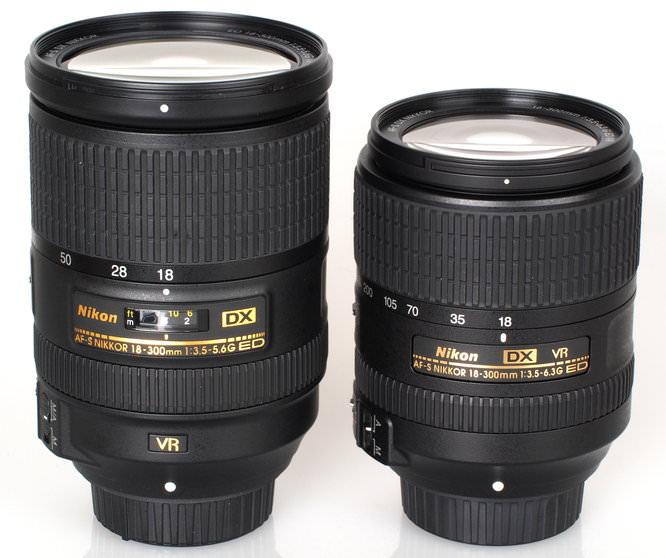
A silent wave motor powers autofocus and speeds are reasonable, but certainly not amongst the fastest. Manual adjustments can be applied at any time via the narrow focusing ring, which is located close to the camera body. Manual focusing action is smooth and well damped, which makes fine adjustments reasonably easy to apply. The zoom action is also very smooth and consistent, not tightening up at any point in the zoom range. Just enough resistance has been applied to prevent the zoom creeping forward when it is pointed down and a switch to lock the lens at 18mm is provided, to prevent the lens from extending when it's removed from a case or bag.
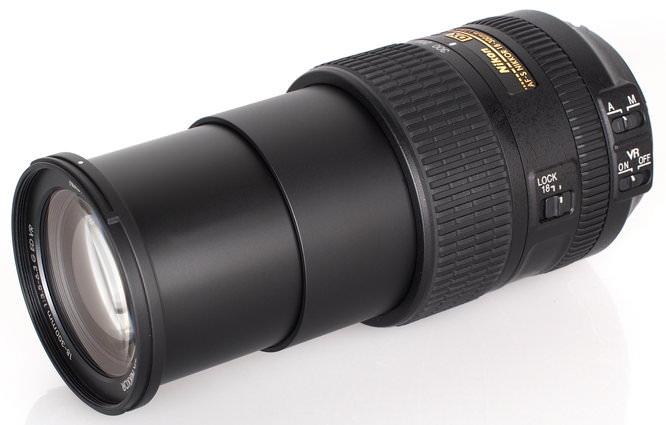
Closest focus distance is 48cm, and focusing is performed internally, so the 67mm filter thread does not rotate, which should make this lens ideal for use with graduated filters and polarisers.
Nikon's Vibration Reduction system promises to allow hand-held shooting at shutter slower than the usual rule of thumb for sharp hand-held photos would allow. The system settles down much quicker than with some other Nikon lenses, providing a steady viewfinder image almost instantly, which is impressive. With care sharp held-held shots were possible at shutter speeds as low as 1/15sec around half the time, which is roughly five stops slower than the usual rule of thumb may recommend.
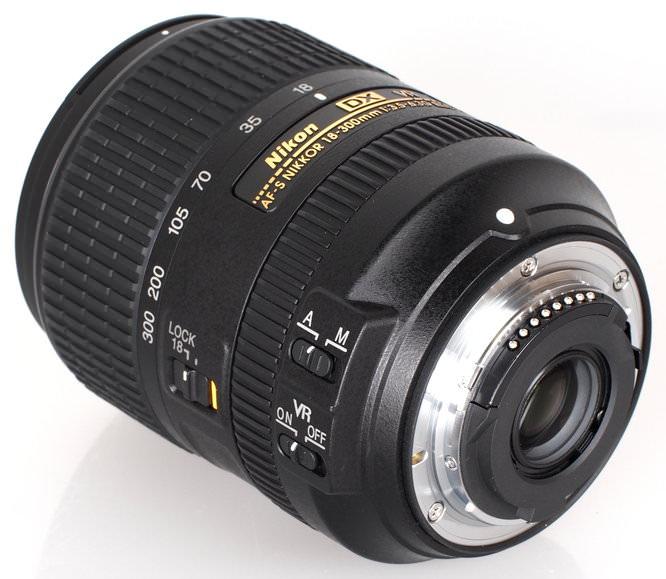
Nikon AF-S DX Nikkor 18-300mm f/3.5-6.3G ED VR Performance
At 18mm and maximum aperture, sharpness is very good in the centre of the frame, and falling just short of good levels towards the edges of the frame. Stopping down to between f/5.6 and f/8 produces outstanding sharpness in the centre of the frame, but the clarity delivered at the edges of the frame never really improves beyond good levels at this focal length.
At 70mm, sharpness is very good in the centre of the frame at maximum aperture, with performance towards the edges only reaching fairly good levels. Stopping down produces a dramatic improvement in performance across the frame, with sharpness being outstanding in the centre and excellent towards the edges of the frame between f/8 and f/11.
Finally, at 300mm, sharpness remains very good in the centre of the frame between f/6.3 and f/11, although performance towards the edges of the frame never really exceeds fairly good levels at this focal length.
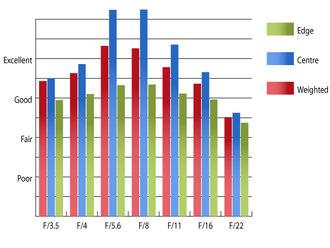 |
 |
| MTF@18mm | MTF@70mm |
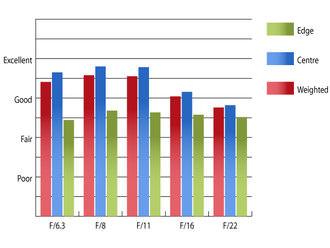 |
How to read our chartsThe blue column represents readings from the centre of the picture frame at the various apertures and the green is from the edges. Averaging them out gives the red weighted column.The scale on the left side is an indication of actual image resolution. The taller the column, the better the lens performance. Simple. For this review, the lens was tested on a Nikon D7100 using Imatest. |
| MTF@300mm |
Levels of chromatic aberrations are an issue for this lens towards the edges of the frame, throughout the zoom range. Fringing is at its most prevalent at 300mm towards the edges of the frame, where it exceeds two pixel widths. This level will be clearly visible along high contrast areas towards the edges of the frame.
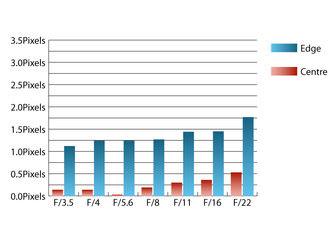 |
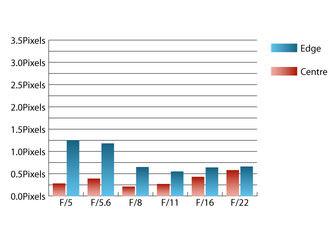 |
| CA@18mm | CA@70mm |
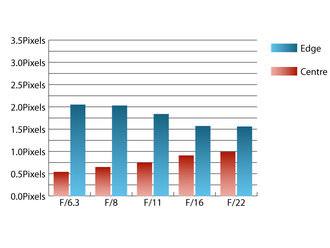 |
How to read our chartsChromatic aberration is the lens' inability to focus on the sensor or film all colours of visible light at the same point. Severe chromatic aberration gives a noticeable fringing or a halo effect around sharp edges within the picture. It can be cured in software.Apochromatic lenses have special lens elements (aspheric, extra-low dispersion etc) to minimize the problem, hence they usually cost more. For this review, the lens was tested on a Nikon D7100 using Imatest. |
| CA@300mm |
Falloff of illumination towards the corners of the frame is well controlled for a lens of this type. At 18mm the corners are 1.54 stops darker than the image centre and at 300mm the corners are 1.37 stops darker. Visually uniform illumination is achieved with the lens stopped down to f/8 or beyond throughout the zoom range.
As is often the case with super zoom lenses, distortion is at both ends of the range, although it isn't overly disturbing with this lens. At 18mm 4.5% barrel distortion is present, which is a reasonably high level and at 300mm 1.1% pincushion distortion is present, which is less noticeable. The distortion pattern is uniform across the frame, so any distortion should be relatively easy to correct in image editing software afterwards if required.
A petal-shaped hood is supplied with the lens, which does a decent job of shielding the front element from extraneous light that may cause flare or loss on contrast. Shooting into the light does result in a slight loss of contrast, especially at 300mm, but otherwise, this lens is quite resistant to flare.
Nikon AF-S DX Nikkor 18-300mm f/3.5-6.3G ED VR Sample Photos
Value For Money
This 18-300mm lens costs around £615, which is quite reasonable for a newly released lens. The older bulkier version, that sports an f/5.6 maximum aperture at 300mm, is a touch more expensive at around £630, even though the price has dropped drastically since launch. Nikon's current 18-200mm lens is similarly specified, except for the maximum telephoto setting being 200mm and costs around £580.
The closest offering Sigma produce is their 18-250mm f/3.5-6.3 DC OS HSM lens, which costs around £300. It has a maximum telephoto setting of 250mm. This lens also includes an optical stabiliser and a silent focusing motor, although manual focus override is only possible by switching the lens to its manual focus setting.
Finally, Tamron's 18-270mm f/3.5-6.3 Di II VC PZD lens is their closest offering, which costs around £330. There is a 30mm difference at the telephoto setting. This lens also includes vibration compensation and a silent focusing motor, although full time manual focus override isn't possible, just like with the Sigma lens.
Nikon AF-S DX Nikkor 18-300mm f/3.5-6.3G ED VR Verdict
Those looking for a convenient all-in-one zoom lens for travel, or simply to cut down on lens changes will love the extreme zoom range this 18-300mm lens offers. Sacrificing the f/5.6 maximum aperture at 300mm of this lens' predecessor is a worthwhile compromise in my opinion, as it has resulted in a much more manageable lens that is compact, yet versatile.
Performance is decent for such an extreme zoom lens, especially in the centre of the frame and when stopped down. As far as sharpness is concerned, this lens delivers sharp enough images for general photography and casual users should be chuffed to bits with it. Unfortunately, photographers who insist on the highest levels of optical quality may find this lens a bit too much of a compromise for their needs. If that's the case for you, then a couple of zoom lenses covering shorter ranges will probably be a better choice.
Nikon AF-S DX Nikkor 18-300mm f/3.5-6.3G ED VR Review: The new Nikon AF-S DX Nikkor 18-300mm f/3.5-6.3G is a compact, yet versatile all-in-one lens for ideal for travel.







